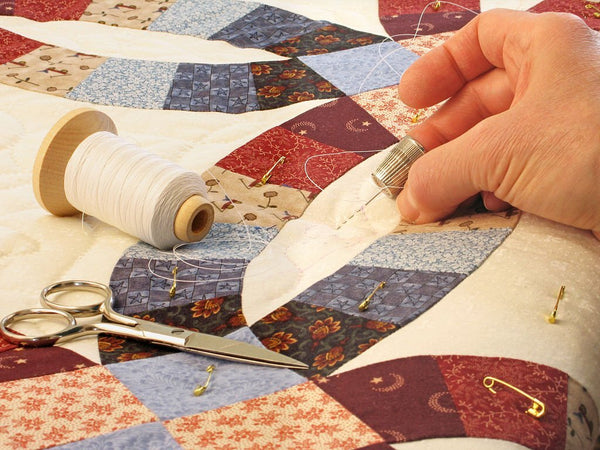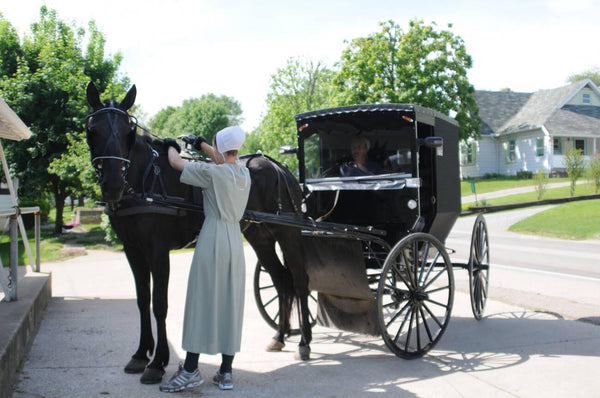The objects and architecture that surround us, as well as our creation, consumption, and trade of these items, all constitute our material culture. It’s borne and shaped by our history, our norms, and our values. Every cultural group has its own unique material culture, including the Amish.
But what is the Amish material culture, and how does it differ from most western societies? Has it undergone fewer changes than other cultures because of Amish isolation? We delved into the Amish material culture and examined the contributing factors that make it what it is today.
What this article covers:
- What is Material Culture?
- How Do Amish Beliefs Tie Into Material Culture?
- The Influence of Amish Nonmaterial Culture
- The Difference Between Amish Material Culture and Other Material Cultures
What is Material Culture?

Material culture describes a cultural group’s tangible aspects, such as their tools, structures, consumer goods, and even infrastructure like man-made dams and canals.
They’re the things you can see and touch, the physical representation of a group of people.
Different countries and nationalities were often identified by unique aspects of their material culture. A few examples of this are the red double-decker buses in London, wooden clogs in Amsterdam, and yellow taxi cabs in New York.
However, with the march of time, and the advent of multiculturalism, many of these distinctions are becoming blurred. Material cultures are becoming less distinctive, and more universal.
Nonmaterial Culture
Nonmaterial culture describes the intangible aspects of a culture. The language, literature, religious beliefs, political ideologies, and artistic expression of a group are its nonmaterial culture, and so are the norms, values, and customs that arise from these belief systems.
Their influence can be seen in the material culture. They’re what drives us to produce the items in our material culture. Nonmaterial culture inspires our creation and mass production.
Nonmaterial cultural expressions, with the exception perhaps of languages, also have fewer distinctions between the various people groups as time goes by. As religions and political ideologies are increasingly shared, their reach extends far beyond their point of origin.

How Do Amish Beliefs Tie into Material Culture?
So, how do Amish beliefs tie in? Once again, we can distinguish between material and nonmaterial culture. The Amish have lived isolated from the rest of America (and the world) for centuries.
While they’ve been exposed to minimal influences from the ‘outside’, their reluctance to assimilate has preserved their distinct material and nonmaterial cultures through the generations.
Amish material culture includes tangible things that have become iconic representations of their culture. Here are some of the most recognizable Amish material culture examples. You may be familiar with some of these already.
Amish Horse-Buggies
The traditional Amish horse and buggy is a common sight along certain country roads in America. It’s an instantly recognizable example of Amish material culture.
This is their mode of transport, much like the modern automobile is for non-Amish people. The Amish don’t drive or own automobiles, although they may sometimes use public transportation.

Wooden Barns and Similar Structures
Amish architecture is simple yet sturdy. Structures are erected through hard labor and built with wood. While these wooden barns, houses, and schoolhouses are string, they’re functional.
No excess decor aspects are visible, and their style has remained largely unchanged for centuries. However, the now famous Amish blue door is one example of how certain Amish communities express themselves as a group.
Amish Wooden Arts and Crafts
The Amish, the men, in particular, are known for their excellent woodworking skills. This is evidenced not only by their structures but also by their furniture.
Amish wooden crafts and furniture are so well made, that they’re highly sought after by non-Amish communities, too. Produced with hand tools, they are a testament to their fine workmanship. Once again, these are more functional than ornate.
Hex Signs/ Amish Barn Signs

While there’s an ongoing debate about the nature of Amish barn symbols (also known as Hex signs), they’ve become yet another symbol of Amish culture.
These physical representations of natural images and stars are said to offer a protective benefit. Whether or not this is true, they’re manmade items that embody the Amish folk culture, and hence an example of Amish material culture.
Amish Wicker Baskets
Yet another item that has become synonymous with the Amish culture, is the handwoven wicker basket. The skill of making Amish baskets has been handed down through the generations.
And these handmade products are loved not only for their practical use in the Amish community but also as a means of income. Amish baskets are used in the community, and outside it, for a variety of different purposes.
Fresh produce is gathered in the community in gardeners’ harvest baskets. These baskets are ideal for your trips to the farmers’ market, too. Practical yet pretty, they’ll serve you for many years, as they do the Amish farmers.
Their hanging file folder baskets are as useful in your home office as they are in any Amish schoolhouse. You’ll love the touch of rustic charm they lend to your office or study room.
And who can resist the country cottage style of their countertop bread boxes? These make ideal gifts for anyone who loves the farmhouse decor aesthetic.
Hand Sewn Amish Quilts
Quilting is another Amish craft that has never waned in popularity. They’ve become not only a symbol of Amish material culture but have crept into non-Amish American material culture as well.
This traditional art form has influenced many American women’s sewing groups. Hand Stitched Amish quilts, much like the baskets, are put to use within the Amish community as well as sold for profit. Therefore, they belong to the Amish material culture.
Traditional Amish Clothing
Amish people wear their own, distinct clothing and refrain from adapting to modern fashion trends. These garments, from the women’s long dresses and bonnets to the men’s suspenders with trousers and wide-brimmed hats, resemble European peasant attire of the distant past.
The Amish produce their garments by hand and favor function over form. Their clothing has to meet strict guidelines as set out by their faith and their laws, resulting in a rigidly traditional dress code. This is meant to uphold the principles of humility and modesty, while also encouraging uniformity amongst the group.

The Influence of Amish Nonmaterial Culture
Although the nonmaterial culture of any group is intangible, its influence can nonetheless be seen in their material culture. This applies to the Amish as well. Their nonmaterial culture is best represented by the following:
Amish Faith
The Old Order Amish religion is the most powerful of all its nonmaterial cultural aspects. Its influence can be observed everywhere in their communities. As a staunch protestant Christian society, they base all that they do on their religious beliefs and values.
Church life takes up a large portion of Amish people’s time. They attend church on Sundays, on religious holidays, and for all weddings. There’s no such thing as a secular wedding in the Amish community.
Ordnung and Law

The Ordnung is the Amish book of laws. It arose from their interpretation of religious texts as well as their adaptation to everyday life. The Ordnung is regularly revised but has yet to be changed much since the Amish first settled in North America.
The Amish follow the Ordnung much like outsiders follow their local laws and statutes. However, compliance is much higher in the Amish community than elsewhere. Just as the outside world has penalties for disobedience, so do the Amish. However, there’s a massive distinction in the way both societies penalize offences.
Penalties for Law Breaking
The penalties among the non-Amish for breaking laws tend to focus on paying fines, community service, or incarceration. Amish penalize their community members for wilful disobedience of their highest laws by shunning, or in extreme cases, ex-communication.
This is the major difference between Amish and non-Amish law. Whereas non-Amish penalties are meant to dissuade people from offending, through the threat of major inconvenience (fines and prison terms), the Amish are penalized in a far more personal way.
By being cut off from their communities and families, Amish offenders feel the consequences of their actions more personally. It is a major deterrent to law-breaking. Also, the fact that most of their laws are based on their faith, means few Amish wilfully disobey them. To do so, would be to disobey God.
Pennsylvania Dutch Language
Although the language that the Amish speak is a dialect of Old High German, it came to be known to outsiders as Pennsylvania Dutch. It’s spoken only by the Amish people.

Unlike most modern languages, it’s remained mostly unchanged for centuries. The main reason why modern colloquial speech hasn’t crept into the Amish vocabulary is their isolation from modern society.
The other reason is their avoidance of the technologies that would expose them to modern languages, such as television, contemporary pop music, and social media.
The Difference Between Amish Material Culture and Other Material Cultures
While any group’s nonmaterial culture changes very slowly over time, the material culture is subject to much more rapid and dramatic changes. Fashions come and go, trends rise and fall, and architectural styles adapt through the ages. This is fairly common in most western societies.
The Amish, however, have a material culture that’s hardly changed since its inception in the 1700s. Their structures, clothing, handicrafts, and even their recipes have remained constant over time. Much of this has to do with their seclusion and strict adherence to their laws.
The Influence of Amish Culture on American Material Culture

Whereas few outside influences have left their mark on Amish’s day-to-day life, the opposite can’t be said. The Amish have, in their own, quiet way, been influential on non-Amish American material culture.
Their woodworking crafts, barns, hex signs, quilts, and wicker baskets have been accepted and treasured by the greater American community, and are now symbols of American material culture, not only Amish culture. Although they may live in isolation, their creativity knows no boundaries.
Conclusion
Like a time capsule buried within America, the Amish have retained both their nonmaterial and material culture, preserving it for centuries. And there seems to be no reason why it shouldn’t continue this way for many more years.
Did You Find Our Blog Helpful? Then Consider Checking:
- Amish School House
- Do Amish Go to School
- Amish Education
- Amish Dress Code
- Amish Beard Rules
- Amish Hair Rules
- Do Amish Make Their Own Clothes
- Do Amish Wear Shoes
- Amish History
- What Language Does the Amish Speak
- Types of Amish
- Amish Traditions
- What Do the Amish Wear to Bed
- Mennonite vs Amish
- Why Did the Amish Split from the Mennonites


